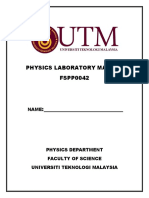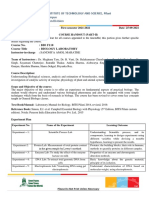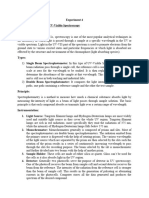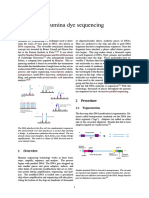Bio f244 Instrumental Methods of Analysis1
Bio f244 Instrumental Methods of Analysis1
Uploaded by
Gabriel SynthesisCopyright:
Available Formats
Bio f244 Instrumental Methods of Analysis1
Bio f244 Instrumental Methods of Analysis1
Uploaded by
Gabriel SynthesisOriginal Description:
Copyright
Available Formats
Share this document
Did you find this document useful?
Is this content inappropriate?
Copyright:
Available Formats
Bio f244 Instrumental Methods of Analysis1
Bio f244 Instrumental Methods of Analysis1
Uploaded by
Gabriel SynthesisCopyright:
Available Formats
BIRLA INSTITUTE OF TECHNOLOGY AND SCIENCE, Pilani
Pilani Campus
Instruction Division
Second semester 2017-18
Date: 08/01/2018
COURSE HANDOUT (PART-II)
In addition to Part I (General Handout for all courses appended to the time table) this portion gives
further specific details regarding the course).
Course No. : BIO F244
Course Title : Instrumental Methods of Analysis
Instructor-in-charge : UMA S. DUBEY
Instructor : Manoj Kannan, Shahid Khan, Aastha Mittak, Neelam Mahala, Pinki,
Nandita, Monica and Shubra Das
1. Scope & Objective of the Course:
The advent of dedicated bio-instruments and computers has facilitated an explosive progress in the
instrumental methods of analysis in biology. Large number of data points, whether they are
physicochemical or biological, can be collected, stored, manipulated and analyzed with a high
precision with the help of modern sophisticated instruments having high sensitivity, selectivity, and
extremely low detection limit. This course aims at providing a sufficient background of these
instruments, their handling and application, in the field of molecular biology, structural biology and
biotechnology.
2. Text Book:
T1. “Instrumental Methods of Analysis”, B. Sivasankar, Oxford Higher education 2012
Reference Book:
R1. “Instrumental Methods of Analysis”, Williard et. al., CBS Publication, New Delhi, 7th ed., 1998.
R2. “Handbook of Analytical instruments”, R.S. Khandpur, Tata Mc Graw-Hill, 2nd edition, 2006.
R3. “Lab Manual for PHA C391 IMA”, Mahesh et. al, 2008.
Please Do Not Print Unless Necessary
BIRLA INSTITUTE OF TECHNOLOGY AND SCIENCE, Pilani
Pilani Campus
Instruction Division
3a. Lecture Plan:
S. Learning Objectives Topics to be covered Book
No.
1 Introduction Introduction to Instrumental Methods T-1, R-1, R-3
2 Spectroscopy Characteristic of atomic and molecular T-1, R-1, R-3
spectroscopy
3 Spectroscopy Visible and Ultraviolet Spectroscopy T-1, R-2, R-3
4 Spectroscopy Fluorescence Spectroscopy T-1, R-1, R-2
5 Spectroscopy Flame Emission Spectroscopy T-1, R-1, R-2
6 Spectroscopy Infrared Spectrophotometry T-1, R-1, R-2
7 Polarimetry Polarimetry R-3
8 Electrophoresis Introduction to Electrophoresis T-2, R-1
9 Electrophoresis High Voltage Electrophoresis T-1
10 Electrophoresis PAGE & Agarose gel electrophoresis T-1
11 Thermo cycler Polymerase Chain Reaction T-1
12 Chromatography Thin Layer Chromatography / Flash T1, Notes
Chromatography
13 Chromatography Gas Chromatography T-1, R-1, R-2
14 Chromatography High-Performance liquid Chromatography T-1, R-1, R-2
15 Flow Cytometry Fluorescence Activated Cell Sorting Notes
3b. Lab Components:
Experiments:
Exp 1: Qualitative and quantitative analysis of given sample using UV-Vis spectroscopy.
Exp 2: Analyzing the chemical structure of molecules using FTIR.
Exp 3: Spectrofluorimetric estimation of quinine sulphate and fluorescence quenching of the same by
potassium iodide
Exp 4: Polarimeteric analysis of samples possessing optical activity
Exp 5: Flame photometric analysis of alkaline earth metals in solutions
Exp 6: Separation of amino acids using High Voltage EP / pH metry.
Exp 7: Separation of drugs using TLC
Exp 8: Detection of antigen using ELISA reader
Exp 9: Amplification of DNA using PCR & Agarose gel electrophoresis
Exp 10: Separation of proteins using PAGE followed by Gel documentation
Demonstrations:
1. Purification of compounds using Flash Chromatography/HPTLC
2. Separation of metabolites/drugs using GC/HPLC
3. Purification of protein mixture using FPLC
4. Flow cytometry (FACS)
_
Please Do Not Print Unless Necessary
BIRLA INSTITUTE OF TECHNOLOGY AND SCIENCE, Pilani
Pilani Campus
Instruction Division
Note: Minor changes are possible subject to availability of chemical s/ Instrument working.
4. Evaluation Scheme:
No. Evaluation Component Duration Weightage Date & Time Venue
1. Laboratory Evaluation-1: - 15% Continuous IMA
Evaluation will be based on Ist cycle Lab
experiments, punctuality, records, and
participation and Viva.
2. Lab Quizzes - 12.5% To be -
Announced
3. Mid Sem Test 1 hr. 10% 5/3 11:00 -
12:30 PM
4. Class Quizzes and assignments - 15% To be announced -
5. Laboratory Evaluation-2: - 15% Continuous IMA
Evaluation will be based on 2nd cycle Lab
experiments, attendance, records,
participation and viva.
6. Lab comprehensive examination - 12.5% To be announced IMA
Lab
7. Comprehensive Exam 2 hrs. 20% 1/5 AN
5. Guidelines to Writing Lab Reports:
The Experiments should be written on hardbound, covered practical files. It should include the
following: Objective, Principle, Materials required, Procedure, Results, Inference, Precautions
& Applications.
6. Chamber Consultation Hours: To be announced in class/by respective instructors
7. Make-up Policy: Make-up will be granted only in the case of hospitalization after
submission of medical certificate. Prior permission is required for any other emergency situations.
Instructor-in-charge
BIO F244
Please Do Not Print Unless Necessary
You might also like
- ONCAMPUS Scheme of Work: Academic Year 2022-23Document36 pagesONCAMPUS Scheme of Work: Academic Year 2022-23victoryNo ratings yet
- Course Outline For Analytical Chemistry3Document4 pagesCourse Outline For Analytical Chemistry3Ernest Kwabena AnointedNo ratings yet
- Pharmaceutical Inorganic Chemistry - PracticalDocument4 pagesPharmaceutical Inorganic Chemistry - PracticalHaritNo ratings yet
- Gel Filtration ChromatographyDocument11 pagesGel Filtration ChromatographyEbruAkharmanNo ratings yet
- Spring 2022 Analytical Techniques Course OutlineDocument4 pagesSpring 2022 Analytical Techniques Course OutlineAreeshaNo ratings yet
- 2387 1311 4242 SyllabusDocument6 pages2387 1311 4242 SyllabusmaryjaneapuadaNo ratings yet
- SBIA 022 Practical ManualDocument42 pagesSBIA 022 Practical ManualNjabulo PetronelNo ratings yet
- 1001 WESAL Quiz 2 AswersDocument1 page1001 WESAL Quiz 2 AswersAlia alotaibiNo ratings yet
- Diktat Praktikum Kimia III BDocument60 pagesDiktat Praktikum Kimia III BIswara ArutalaNo ratings yet
- EEE321L - Course OutlineDocument3 pagesEEE321L - Course Outlinesusmoy.kundu.infoNo ratings yet
- Bio F110 1001Document2 pagesBio F110 1001AmanNo ratings yet
- Radiology and Radiation SafetyDocument4 pagesRadiology and Radiation Safetycoordinator.dargaiNo ratings yet
- Manual FSPP0042Document59 pagesManual FSPP0042kaiyeeNo ratings yet
- Student Lab ManualDocument25 pagesStudent Lab ManualCucu AlbertNo ratings yet
- 2024 122201-Lab Man-V5Document155 pages2024 122201-Lab Man-V5c6jdxj8t9sNo ratings yet
- PHY F110 Physics LabDocument2 pagesPHY F110 Physics LabAnsheekaNo ratings yet
- Sas Handour EEE f243Document3 pagesSas Handour EEE f243johnmechanjiNo ratings yet
- BME401 - Introduction To BiotechnologyDocument5 pagesBME401 - Introduction To BiotechnologyDr. Rabah Al abdiNo ratings yet
- CYC 517 Physical Chemistry Lab II MSC 3rd SEMDocument36 pagesCYC 517 Physical Chemistry Lab II MSC 3rd SEMDebanjan DasNo ratings yet
- Physics 1 Laboratory Manual Year 2021Document66 pagesPhysics 1 Laboratory Manual Year 2021Hafiz IrfanNo ratings yet
- BSK1402 ORGANIC CHEMISTRY MANUAlDocument25 pagesBSK1402 ORGANIC CHEMISTRY MANUAlaayana angelNo ratings yet
- National University of EngineeringDocument2 pagesNational University of EngineeringMarco A. Castillo LudeñaNo ratings yet
- Chemistry 4346 SyllabusDocument4 pagesChemistry 4346 SyllabusAliceNo ratings yet
- Applied Physics Lab 2017 18Document2 pagesApplied Physics Lab 2017 18khairun MunnyNo ratings yet
- Online Classes ScheduleDocument5 pagesOnline Classes ScheduleMIbrahimNo ratings yet
- Lab Manual KC 31001 Laboratory 6: Semester 2 2016/2017Document70 pagesLab Manual KC 31001 Laboratory 6: Semester 2 2016/2017Debrah DebbieNo ratings yet
- Birla Institute of Technology and Science, Pilani Birla Institute of Technology and Science, Pilani Birla Institute of Technology and Science, PilaniDocument3 pagesBirla Institute of Technology and Science, Pilani Birla Institute of Technology and Science, Pilani Birla Institute of Technology and Science, PilaniAyush JoshiNo ratings yet
- Pam Lab ReportDocument3 pagesPam Lab Reportbucci254No ratings yet
- Ochem Lab SyllabusDocument6 pagesOchem Lab SyllabuslolaNo ratings yet
- BME401 - Introduction To BiotechnologyDocument5 pagesBME401 - Introduction To BiotechnologyDr. Rabah Al abdiNo ratings yet
- Sem 720Document12 pagesSem 720Triasha DasNo ratings yet
- Syllabus 021-025 Physics For Science and Engineering Students Laboratory IIIDocument48 pagesSyllabus 021-025 Physics For Science and Engineering Students Laboratory IIIAndargie GeraworkNo ratings yet
- Eee f341 Analog Electronics1Document3 pagesEee f341 Analog Electronics1Sai AmithNo ratings yet
- Fourier Transform Infrared Spectroscopy Across The Chemistry CurriculumDocument16 pagesFourier Transform Infrared Spectroscopy Across The Chemistry CurriculumJonathanNo ratings yet
- Lab ExperimentDocument4 pagesLab ExperimentAkhilaa ServaiNo ratings yet
- E Manual of Etph151Document52 pagesE Manual of Etph151Pratham ChhabraNo ratings yet
- ImmunologyDocument65 pagesImmunologyLuthfi LazuardiNo ratings yet
- Syllabus M.SCDocument21 pagesSyllabus M.SCsureshNo ratings yet
- Bio F110 1001Document3 pagesBio F110 1001qweNo ratings yet
- ECLR17 Communication Engineering Lab BDocument5 pagesECLR17 Communication Engineering Lab BAishwarya RNo ratings yet
- E3 Screw Thread Measurement BMMP2503 New FormatDocument13 pagesE3 Screw Thread Measurement BMMP2503 New FormatBlue BeatleNo ratings yet
- CHEM F329-Analytical ChemistryDocument2 pagesCHEM F329-Analytical ChemistrySai Kiran TulluriNo ratings yet
- CH341 SP 24Document5 pagesCH341 SP 24j perryNo ratings yet
- Department of Chemistry, Ateneo de Manila University 1st Semester, School Year 2012-2013 C209, T 0730-1130Document6 pagesDepartment of Chemistry, Ateneo de Manila University 1st Semester, School Year 2012-2013 C209, T 0730-1130Eisen AguilarNo ratings yet
- Third YearDocument8 pagesThird Yeardaniel nyamandiNo ratings yet
- Sample Proposal PDFDocument4 pagesSample Proposal PDFHaqeem HNo ratings yet
- MPharm-Pharmaceutical AnalysisDocument31 pagesMPharm-Pharmaceutical AnalysisTharun KumarNo ratings yet
- Water and Environmental Chemistry Laboratory: Spring 2015Document41 pagesWater and Environmental Chemistry Laboratory: Spring 2015Anam ButtNo ratings yet
- Rad316 - PPT.1Document15 pagesRad316 - PPT.1fatymohammad1dNo ratings yet
- Guidelines and InstructionsDocument5 pagesGuidelines and InstructionsArvin LiangdyNo ratings yet
- Introduction and Excel ExerciseDocument29 pagesIntroduction and Excel ExerciseMatthewNo ratings yet
- GKFNZD GKFNZD GKFNZD GKFNZD Lokxr Lokxr Lokxr Lokxr: GKFNZD GKFNZD GKFNZD GKFNZD Lokxr Lokxr Lokxr LokxrDocument19 pagesGKFNZD GKFNZD GKFNZD GKFNZD Lokxr Lokxr Lokxr Lokxr: GKFNZD GKFNZD GKFNZD GKFNZD Lokxr Lokxr Lokxr LokxrRagvendra BistNo ratings yet
- Syllabus Chem 0303316 Instrumental Analysis Laboratory: Fall 2011/ 2012Document4 pagesSyllabus Chem 0303316 Instrumental Analysis Laboratory: Fall 2011/ 2012Dalu ChockiNo ratings yet
- Chemical Engineering LabDocument3 pagesChemical Engineering LabKamal KhemkaNo ratings yet
- Birla Institute of Technology and Science, Pilani: Pilani Campus AUGS/ AGSR DivisionDocument3 pagesBirla Institute of Technology and Science, Pilani: Pilani Campus AUGS/ AGSR DivisionKamal KhemkaNo ratings yet
- UT Dallas Syllabus For Te3101.501.07s Taught by Tanay Bhatt (tmb018000)Document2 pagesUT Dallas Syllabus For Te3101.501.07s Taught by Tanay Bhatt (tmb018000)UT Dallas Provost's Technology GroupNo ratings yet
- Birla Institute of Technology and Science, Pilani Pilani Campus Instruction DivisionDocument2 pagesBirla Institute of Technology and Science, Pilani Pilani Campus Instruction Divisionsaurjyesh nayakNo ratings yet
- BIOLOGY LABORATORYDocument2 pagesBIOLOGY LABORATORYaaanonymouss987654321No ratings yet
- Student Lab ManualDocument54 pagesStudent Lab ManualCucu AlbertNo ratings yet
- LABORATORY MANUAL FOR A MINI PROJECT: MSCB 1113 BIOCHEMISTRY & MICROBIAL PHYSIOLOGYFrom EverandLABORATORY MANUAL FOR A MINI PROJECT: MSCB 1113 BIOCHEMISTRY & MICROBIAL PHYSIOLOGYNo ratings yet
- MC3 Lab 1 & 2Document3 pagesMC3 Lab 1 & 2Princess Javier TorcelinoNo ratings yet
- Fluorescence Staining Manual Thermo FisherDocument3 pagesFluorescence Staining Manual Thermo FisherMargauxNo ratings yet
- Lab Report Exp 6Document5 pagesLab Report Exp 6api-384913960No ratings yet
- DROP DialysisDocument1 pageDROP DialysisshivaanikNo ratings yet
- Spectrochemical AnalysisDocument6 pagesSpectrochemical Analysisroku shinNo ratings yet
- Gas Chromatography - Pre LabDocument5 pagesGas Chromatography - Pre Labhsong1667_335913186No ratings yet
- Tab MEDILOX 250 MG: Product Testing MethodDocument2 pagesTab MEDILOX 250 MG: Product Testing MethodMohammed ZubairNo ratings yet
- UV VisDocument2 pagesUV Vist4424914No ratings yet
- Topic 6-Molecular Genetics-Part 2: Fly EmbryosDocument26 pagesTopic 6-Molecular Genetics-Part 2: Fly EmbryosMarshall GorgonzolaNo ratings yet
- DNA FingerprintingDocument3 pagesDNA FingerprintingDaniel NguyenNo ratings yet
- AN 360 Rapid Determination of Azo Dyes in Textiles Using Dionex ASE and UltiMate 3000 HPLC SystemsDocument6 pagesAN 360 Rapid Determination of Azo Dyes in Textiles Using Dionex ASE and UltiMate 3000 HPLC SystemsDewi WulandhariNo ratings yet
- Analytical Chemist Service Technician in Denver CO Resume Timothy O'DonnellDocument2 pagesAnalytical Chemist Service Technician in Denver CO Resume Timothy O'DonnellTimothyODonnellNo ratings yet
- Report 1Document11 pagesReport 1LinhNguye100% (1)
- Fundamentals of HPLCDocument37 pagesFundamentals of HPLCrahatulislam100% (1)
- PCR SystemDocument1 pagePCR SystemJorgeNo ratings yet
- Molecular Spectroscopy Syllabus First Semester 20092010Document1 pageMolecular Spectroscopy Syllabus First Semester 20092010DrHamdy KhameesNo ratings yet
- Illumina Dye SequencingDocument5 pagesIllumina Dye SequencingNguyen TaNo ratings yet
- ITA Viva - Questions OnlyDocument4 pagesITA Viva - Questions OnlyManoj KhanalNo ratings yet
- Scanning Electron MicrosDocument11 pagesScanning Electron MicrosRizki Yuni PratiwiNo ratings yet
- Biological Techniques TechniquesDocument13 pagesBiological Techniques TechniquesDr. Dhondiba VishwanathNo ratings yet
- Spectrochemical Analysis - Metal Casting ResourcesDocument11 pagesSpectrochemical Analysis - Metal Casting ResourcesAmarjeet SinghNo ratings yet
- Spectrophotometry 1Document3 pagesSpectrophotometry 1Christina AtefNo ratings yet
- Köhler Illumination: PrinciplesDocument3 pagesKöhler Illumination: PrinciplesGiovany Marín100% (1)
- Standard Operating Procedure (SOP) : 1. General ConsiderationsDocument7 pagesStandard Operating Procedure (SOP) : 1. General ConsiderationsAlemayehu Letebo AlbejoNo ratings yet
- ANALYSIS Text BookDocument83 pagesANALYSIS Text BookSwapna GodayNo ratings yet
- Spektro Uv Vis Hurnal1Document9 pagesSpektro Uv Vis Hurnal1cahyaNo ratings yet
- Candy ChromatographyDocument13 pagesCandy Chromatographypsudha3100% (1)
- Good Chromatography Practices - SOP & Guideline - Pharma BeginnersDocument46 pagesGood Chromatography Practices - SOP & Guideline - Pharma BeginnersSAISIVARAMAKRISHNA KATTULA100% (1)
























































































